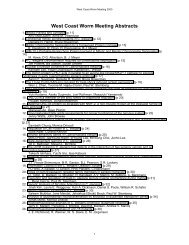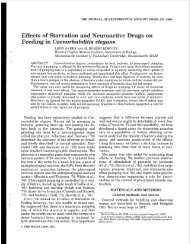Program of the 2004 East Coast Worm Meeting - Caenorhabditis ...
Program of the 2004 East Coast Worm Meeting - Caenorhabditis ...
Program of the 2004 East Coast Worm Meeting - Caenorhabditis ...
You also want an ePaper? Increase the reach of your titles
YUMPU automatically turns print PDFs into web optimized ePapers that Google loves.
29. Genes Controlling Sensory Axon Patterning in <strong>the</strong> C. elegans Male Tail<br />
Lingyun Jia, Scott W. Emmons<br />
Albert Einstein College <strong>of</strong> Medicine, Bronx, 10461, USA<br />
The C. elegans male exhibits sex-specific behaviors like mate searching and copulation. The<br />
generation and modification <strong>of</strong> such behaviors depends on <strong>the</strong> precise connections between<br />
male-specific neurons. However, how <strong>the</strong> male-specific circuits are established during<br />
development is not well known. We initiated a genetic analysis by focusing on sensory neurons <strong>of</strong><br />
<strong>the</strong> rays to identify genes involved in this process. We first demonstrated by using fluorescent<br />
protein that each ray axon takes a distinct but stereotyped pathway into <strong>the</strong> preanal ganglion and<br />
is highly branched <strong>the</strong>re, identical with previous study by Sulston(1980). In a genetic screen for<br />
mutations with abnormal ray axon morphology, we isolated mutations in nine genes that cause a<br />
diversity <strong>of</strong> ray axon morphology defects. A subset <strong>of</strong> <strong>the</strong>se mutations define two non-sex-specific<br />
genes: unc-27 and sax-2, and two potentially new genes: egl-35 and rax-2 with sex-specific<br />
functions.<br />
unc-27 encodes troponin I, a subunit <strong>of</strong> Troponin Complex. Our results show that UNC-27/TnI<br />
controls axon pathway by ordering muscle position and <strong>the</strong> substrate for <strong>the</strong> axons to migrate<br />
along, indicating that nerves and muscles are spatially coincidently regulated during<br />
development. unc-27 loss <strong>of</strong> function results in axon wandering. Polarized microscope analysis<br />
demonstrated that mutations in unc-27 distort <strong>the</strong> evenly spaced dense bodies, detaching muscle<br />
from basement membrane and epidermis. Mutations in most genes encoding my<strong>of</strong>ilament<br />
proteins do not affect axon guidance except for mup-2/TnT, ano<strong>the</strong>r subunit <strong>of</strong> <strong>the</strong> Troponin<br />
Complex that is also required for muscle cell positioning during development. We showed by<br />
mosaic analysis that UNC-27 expression in muscles but not in neurons or hypodermis rescued<br />
<strong>the</strong> axon wandering; suggesting muscles provide a scaffold for axon pathfinding.<br />
sax-2 encodes <strong>the</strong> C.elegans homologue <strong>of</strong> <strong>the</strong> drosophila furry, a conserved protein without<br />
any known functional domains. sax-2 plays an important role in maintaining axon morphology.<br />
The mutation sax-2(bx130) causes ray neurons to send supernumerary processes in <strong>the</strong> adult<br />
stage and reduces <strong>the</strong> density <strong>of</strong> <strong>the</strong> presyanptic vesicles in <strong>the</strong> PAG. It also affects <strong>the</strong> stability<br />
<strong>of</strong> amphid sensory neurons, as do o<strong>the</strong>r sax-2 alleles (Zallen et al, 1999). O<strong>the</strong>r studies have<br />
shown that furry is required for cellular morphogenesis and <strong>the</strong> polarity <strong>of</strong> cell division in <strong>the</strong> fly<br />
and yeast. The disruption <strong>of</strong> neuronal morphology indicates furry is also required for maintaining<br />
integrity <strong>of</strong> <strong>the</strong> mature nervous system. Consistently, <strong>the</strong> reduced density <strong>of</strong> presynaptic vesicles<br />
and <strong>the</strong> low mating efficiency <strong>of</strong> males suggest that sax-2 may play a role in establishing neural<br />
circuits important for copulation.<br />
Finally, two genes, egl-35 and rax-1 (ray axon defect), specifically control ray axon guidance<br />
and also appear to affect sex behaviors. Mutations in egl-35 and rax-1 cause ray axons to fail to<br />
project into <strong>the</strong> PAG, but do not affect <strong>the</strong> non-sex- specific axons, consistent with normal<br />
non-sex-specific behaviors like locomotion. However, egl-35(bx129) males loose attraction to<br />
hermaphrodites and fail to initiate any steps <strong>of</strong> <strong>the</strong> mating program. Our assay for mate searching<br />
(sexual motivation) suggests that bx129 males may have reduced sex drive. Males <strong>of</strong><br />
rax-1(bx132) also exhibit reduced mating frequency. Currently, we are cloning <strong>the</strong>m and<br />
analyzing <strong>the</strong> genetic interaction with known guidance factors and o<strong>the</strong>r rax genes.




